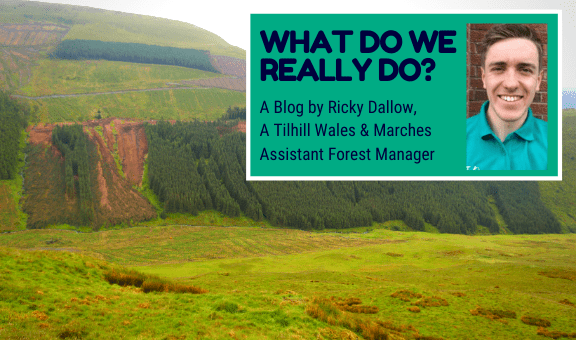This website uses cookies so that we can provide you with the best user experience possible. Cookie information is stored in your browser and performs functions such as recognising you when you return to our website and helping our team to understand which sections of the website you find most interesting and useful.
What do we really do?
With university students finishing their academic year I feel that Tilhill graduate scheme applicants and anyone interested in what we do on the forestry side of the business would find it useful to have an explanation about what we, as foresters, do and how we do it.
At the careers fairs I have attended I always get asked the same question – what do you actually do?. Thankfully for you the reader, I don’t have the chance to write an essay. Instead here’s a whistle-stop tour on what our job entails. This isn’t a day in the life as such, as Mike Page has an excellent blog covering this already.
Forest Planting and Maintenance
From site preparation, planting, re-spacing, weeding, fencing or pruning; every compartment of young trees requires establishment, maintenance and some TLC to ensure they outcompete weeds, damage from insects, and the effects of hungry sheep or deer. Continued monitoring takes place over the first few years of growth to assess survival rates to replace losses, damage from insecticide and monitoring of weed growth and competition and complete works to help give the trees a ‘kick start’
Timber harvesting
From timber mensuration; thinning and clear-fells to tree safety surveys. These operations provide material for construction, fencing, pallets and biomass all of which play an important role in the provision of raw material to the UK economy. The scale of these operations differs and depend on site characteristics such as species, environmental features, client’s objectives and public access to name a few.
As we see more pests and diseases within the UK and further abroad, species such as Larch and Ash are going to be facing a difficult few years and we will slowly see less and less of these species. As sad as this is, it provides opportunities for forest managers, alongside nurseries, to explore suitable replacements. My colleagues in the harvesting team at Tilhill are in a much better place to discuss their roles, which you will find out more when they too release their blogs – I wouldn’t want to steal their thunder.
Forest Planning & Woodland Management
Throughout the above operations, forest planning and woodland management underpins it all, whether it is through the completion of necessary permissions; such as felling licences, planning permission, ecological surveys and licences. All of this ensures we complete operations in line with the United Kingdom Forest Standard (UKFS), UK Forestry Act 1967 and other environmental regulations.
Each forest has a long-term plan, a vision in line with the wide range of client’s objectives which Tilhill provides services for; whether it is as a sound investment model, amenity woodlands or game cover crops on estates. These forest plans help identify key environmental features in which we plan to enhance through restructuring or general maintenance operations and helps us give an outline schedule of operations over the foreseeable future. With each woodland possessing differing characteristics when it comes to soil types, access considerations, key stakeholders and species, coupled with the various utilities and environmental or public features you swiftly realise that no two woodlands are the same!
I hope this helps provide a bit of a glimpse into the world of an Assistant Forest Manager for those who are potentially looking for the next step after university, a change in career or just generally interested in what we get up to.
About the writer: Ricky Dallow started with Tilhill on the graduate management programme in June 2018 after completing a BSc in Physical Geography at Aberystwyth and an MSc in Forest management at Harper Adams.
Ricky is currently an associate member of the Institute of Chartered Foresters and is working towards his professional membership.




